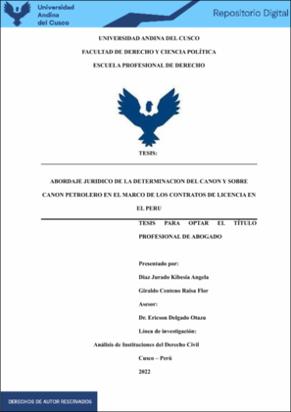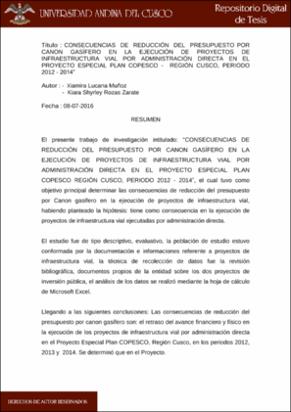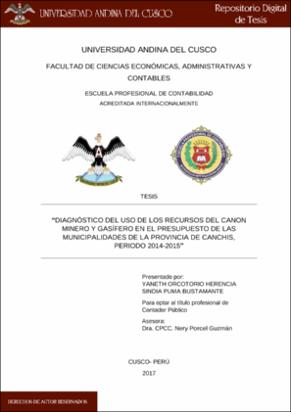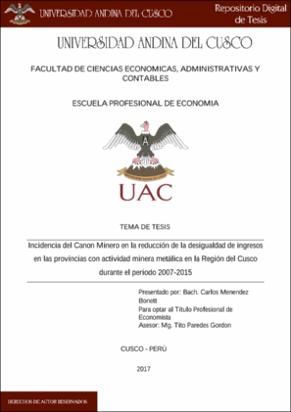| dc.contributor.advisor | Delgado Otazú, Ericson | |
| dc.contributor.author | Diaz Jurado, Kibesia Angela | |
| dc.contributor.author | Giraldo Centeno, Raisa Flor | |
| dc.date.accessioned | 2023-02-27T20:28:50Z | |
| dc.date.available | 2023-02-27T20:28:50Z | |
| dc.date.issued | 2022-12-21 | |
| dc.identifier.uri | https://hdl.handle.net/20.500.12557/5165 | |
| dc.description.abstract | El canon petrolero es un porcentaje sobre los ingresos que reciben las circunscripciones
productoras por la explotación del recurso en su territorio. La normativa ha desarrollado los
parámetros para beneficiar a las circunscripciones productoras, es así que, el artículo 77 de
la Constitución Política del Perú respecto al canon ha señalado que, cada circunscripción
productora será beneficiada por ley teniendo por derecho recibir un porcentaje adecuado del
total de los ingresos y rentas obtenidas por el estado, por la explotación de los recursos
naturales de cada zona, en calidad de Canon.
La regulación regional del Canon inicia el año de 1976 con el departamento de Loreto,
mediante el Decreto Ley N° 21678, el cual asigna el 10% respecto al valor de la producción
de petróleo, que será calculado a partir del precio promedio ponderado de las ventas,
deduciéndole los costos tanto en el mercado interno como externo.
En 1981, se regula el sobrecanon de Ucayali, asignándole un 2.5% del valor de producción
de petróleo en la Selva. En ese mismo sentido, se ha venido regulando bajo diferentes
dispositivos legales el canon y sobrecanon de otras circunscripciones productoras: canon de
Piura y Tumbes en 1983, el canon de Puerto Inca (Huánuco) en 1989 y el canon de Ucayali
en 1998. En ese sentido, se regulo el sobrecanon de Piura y Tumbes en 1984 y el sobrecanon
de Loreto en 1998, manteniendo los parámetros establecidos por el sobrecanon de Ucayali.
La creación del concepto de sobrecanon se construye discrepando del concepto
constitucional de canon, porque el sobrecanon de Ucayali rompe la relación directa que
debería existir entre la circunscripción beneficiaria (Ucayali) y la circunscripción productora
(Loreto), esto se repite en el caso del sobrecanon de Piura y Tumbes.
En la actualidad PERUPETRO S.A., es la empresa encargada de suscribir las dos
modalidades contractuales con los contratistas. 1)Contrato de servicios, en el cual PERUPETRO S.A., contrata con un privado denominado contratista, para que este
(contratista) se encargue de realizar las labores de exploración y explotación, siendo
PERUPETRO S.A., el encargado de comercializar los Hidrocarburos y recibiendo ingresos
por dichas ventas. 2) Contrato de Licencia, PERUPETRO S.A. le otorga la licencia a un
privado denominado contratista para que éste realice las actividades de exploración y
explotación, ejerciendo el contratista un derecho de propiedad sobre los hidrocarburos
explotados por lo que se encuentra en la capacidad de realizar la comercialización de los
hidrocarburos, por ende PERUPETRO S.A. ya no recibe ingresos por ventas, si no regalías.
Es en este punto que se manifiesta la mayor problemática que enfrenta PERUPETRO S.A.
al realizar la determinación del canon y sobrecanon petrolero: la fórmula de determinación
establecida ha quedado desfasada y es que PERUPETRO S.A. ya no solo recibe ingresos por
ventas, sino en este tipo de contrato recibe regalías. | es_PE |
| dc.description.abstract | The oil canon is a percentage of the income received by the producing area for the
exploitation of the resource in their territory. The regulations have developed the parameters
to benefit the producing areas, so that, in article 77 of the Political Constitution of Peru,
respect to the canon, it has been indicated that each producing area will be benefited by law,
having the right to receive an adequate percentage of the total of the income and rents
obtained by the state, for the exploitation of the natural resources of each area, as Canon.
The regional regulation of the Canon began in the year 1976 with the department of Loreto,
through the law No. 21678, which assigns 10% of the value of oil production, which will be
calculated from the weighted average price of sales, deducting costs both in the domestic
and foreign markets.
In 1981, the Ucayali over-canon was regulated, assigning it 2.5% of the value of oil
production in the Jungle. In the same sense, the canon and over-canon of other producing
districts have been regulated under different legal devices: the canon of Piura and Tumbes
in 1983, the canon of Puerto Inca (Huánuco) in 1989 and the canon of Ucayali in 1998.
Likewise, the Piura over-canon was regulated in 1984, and the Loreto over-canon in 1998,
maintaining the parameters established by the Ucayali over-canon.
The creation of the concept of over-canon, was constructed in disagreement with the
constitutional concept of canon, because the over-canon of Ucayali provides that it breaks
the direct relationship that should exist between the beneficiary area (Ucayali) and the
producing area (Loreto), this is repeated in the case of the over-canon of Piura and Tumbes.
PERUPETRO S.A. is the company in charge of signing the two contractual modalities with
the contractors. 1) Service contract, in which PERUPETRO S.A., contracts with a private
called contractor, this (contractor) is then in charge of carrying out the exploration and exploitation tasks, being PERUPETRO S.A., the one in charge of marketing the
Hydrocarbons and receiving income for these sales. 2) License Contract, PERUPETRO
S.A., gives the license to a private named contractor so that he may carry out the activities
of exploration and exploitation of hydrocarbons, the contractor exercising a property right
over the exploited hydrocarbons, therefore PERUPETRO S.A. no longer receive income
from sales, but privileges. It is at this point that the greatest problem facing PERUPETRO
S.A. is manifested. when making the determination of the oil canon and over-canon. The
established determination formula has become outdated, therefore PERUPETRO S.A. does
not receive income from sales, but in this type of contract, one can receive privileges. | en_US |
| dc.format | application/pdf | es_PE |
| dc.language.iso | spa | es_PE |
| dc.publisher | Universidad Andina del Cusco | es_PE |
| dc.rights | info:eu-repo/semantics/openAccess | es_PE |
| dc.rights.uri | https://creativecommons.org/licenses/by-nc-nd/4.0/ | es_PE |
| dc.subject | Canon petrolero | es_PE |
| dc.subject | Determinación del canon | es_PE |
| dc.subject | Canon gasífero | es_PE |
| dc.subject | Contrato de servicio | es_PE |
| dc.subject | Regalías petroleras | es_PE |
| dc.title | Abordaje jurídico de la determinación del canon y sobre canon petrolero en el marco de los contratos de licencia en el Perú | es_PE |
| dc.type | info:eu-repo/semantics/bachelorThesis | es_PE |
| thesis.degree.name | Abogada | es_PE |
| thesis.degree.grantor | Universidad Andina del Cusco. Facultad de Derecho y Ciencia Política | es_PE |
| thesis.degree.discipline | Derecho | es_PE |
| dc.publisher.country | PE | es_PE |
| dc.subject.ocde | https://purl.org/pe-repo/ocde/ford#5.05.00 | es_PE |
| renati.advisor.dni | 41523532 | |
| renati.advisor.orcid | https://orcid.org/0000-0002-9159-6860 | es_PE |
| renati.author.dni | 10550192 | |
| renati.author.dni | 77486489 | |
| renati.discipline | 421016 | es_PE |
| renati.juror | Avendaño Uchuya, Oswalt Nestor | |
| renati.juror | Siles Luque, Rolando | |
| renati.juror | Ríos Mayorga, Julio Trinidad | |
| renati.juror | Calvo Rodriguez, Yuri | |
| renati.level | https://purl.org/pe-repo/renati/level#tituloProfesional | es_PE |
| renati.type | https://purl.org/pe-repo/renati/type#tesis | es_PE |
| dc.description.lineadeinvestigacion | Análisis de las instituciones de derecho civil | es_PE |





